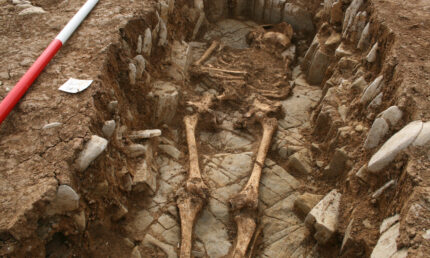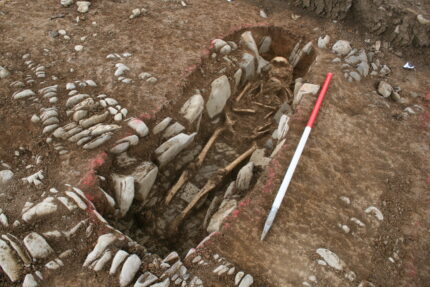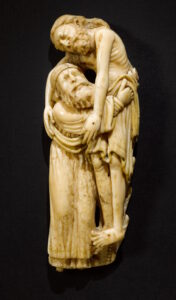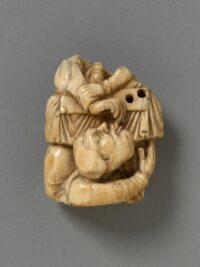 A lead slingbullet inscribed with the name of Julius Caesar and the Ibero-Roman city Ipsca has been discovered in Montilla, Andalusia, southern Spain. It the first time an incontrovertible inscription of Julius Caesar’s name has been found on this type of projectile in the Iberian Peninsula. It is also the first slingbullet inscribed with the place-name Ipsca; indeed, the first toponym of any city in Roman Hispania ever found inscribed on a slingbullet.
A lead slingbullet inscribed with the name of Julius Caesar and the Ibero-Roman city Ipsca has been discovered in Montilla, Andalusia, southern Spain. It the first time an incontrovertible inscription of Julius Caesar’s name has been found on this type of projectile in the Iberian Peninsula. It is also the first slingbullet inscribed with the place-name Ipsca; indeed, the first toponym of any city in Roman Hispania ever found inscribed on a slingbullet.
The practice of putting inscriptions on lead slingshot projectiles (glandes inscriptae) goes back to 5th century B.C. Greece and continued through the early Roman imperial era. The clay molds used to manufacture the shots would be incised so the projectile, once hardened, would feature an inscription in relief on the body. The types of inscriptions commonly included the name of the maker, the military commander, the legion or the place they were to be deployed. Sometimes they included messages to the enemy like “eat this” and “our persistence will destroy you.”
Glandes inscriptae have been found in significant numbers in the Republican Roman provinces of the Iberian Peninsula. A large concentration date to the 1st century B.C., so much so that scholars believed them to be a particular feature of the Sertorian War (82-72 B.C.) and Caesar’s conflict with Pompey (48-45 B.C.), a pointed, as it were, form of self-promotion. Quintus Sertorius added actual slogans like “veritas” and “fides” on the other side of his sling bullets. (Recent studies of glandes inscriptae in private collections have found a few even earlier examples, bearing the names of Roman military leaders who fought Celtiberian tribes in the 2nd century B.C.)
Even if it hadn’t had a tell-tale inscription, the slingbullet found in Montilla was unlikely to have been Sertorian because no known battles in that conflict took place in the area. Its shape and weight are directly comparable to a group of lead projectiles found at the Roman city of Ulia Fidentia, where Caesar and Pompey’s troops clashed, less than eight miles north of the slingbullet’s find site in Montilla. None of the slingbullets found at Ulia were inscribed, which makes the Montilla example all the more notable.
The almond-shaped lead projectile was discovered in 2019 during agricultural work in the town of Montilla near Cordoba. It is one of 18 lead slingbullets discovered in the immediate surroundings of the find site in the course of agricultural work or by happenstance.
The glans inscripta measures 1.8 inches long, .8 inches wide and .7 inches high. It weighs 2.5 ounces. It was manufactured by pouring lead into a clay mold. The pointed ends were cut with shears to separate them from the next bullet in the mold. The projectile is in excellent condition, with just a couple of damage spots typical of soft lead projectiles after they’ve been thrown at an enemy.
It has two longitudinal inscriptions on opposite sides: IPSCA and CAES. Ipsca is the place name of a city. Caes is the abbreviation for Gaius Julius Caesar. While the name of Caesar has been found on slingbullets in Italy, the archaeological context of these discoveries date them to after Julius Caesar’s assassination. They are therefore attributed to Gaius Caesar Octavianus, aka Octavian, Caesar’s nephew, adoptive son and heir who took Caesar’s name after his death. One unpublished slingbullet may bear the abbreviation of Caesar (the photos are unclear and it is not in public view), but the inscription on the other side “Accipe” means “take it” so even if it is Caesar’s name, the bullet itself was likely destined for his side and therefore manufactured by the Pompeian forces.
Ipsca was an Iberian oppidum (fortified town) and later a Roman municipality about 12 miles from Montilla. It was in this countryside that Julius Caesar and the surviving sons of Pompey, Gnaeus and Sextus Pompeius, engaged in the final battle of their civil war in 45 B.C. The exact location of the Battle of Munda has long been subject of debate, with the environs of Montilla being one of the top candidates. The discovery of the lead slingbullet supports this candidacy, and confirms that the city of Ipsca allied itself with Caesar’s faction.
Certainly Ipsca produced ammunition for Caesar, sealing an unbreakable alliance on lead. It was a real sponsorship, that is, a strong sharing of the cause. Hipsca espoused Caesar’s cause. And he wanted to publicly underline it, marking the operation with his name, so that there would be no doubts. The municipality probably also sent its own men to reinforce the Caesarian army in view of the clash at Munda, near present-day Montilla, the territory in which the projectile was found.
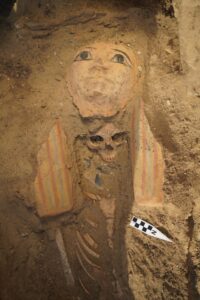 A joint Egyptian-Japanese archaeological mission excavating the Saqqara necropolis has discovered an intact rock-cut tomb dating to the Second Dynasty (ca. 2890 – ca. 2686 B.C.) of the Old Kingdom. The tomb contains the remains of an adult and a small child.
A joint Egyptian-Japanese archaeological mission excavating the Saqqara necropolis has discovered an intact rock-cut tomb dating to the Second Dynasty (ca. 2890 – ca. 2686 B.C.) of the Old Kingdom. The tomb contains the remains of an adult and a small child.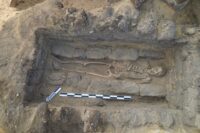 Archaeological remains from the Second Dynasty are much more rare than those from the First and Third. Even the names and regnal order of the pharaohs is unclear as the surviving king lists are lacunose and contradictory, with only the first three and the last one confirmed. The scarcity of Second Dynasty remains makes the newly-discovered tomb particularly significant.
Archaeological remains from the Second Dynasty are much more rare than those from the First and Third. Even the names and regnal order of the pharaohs is unclear as the surviving king lists are lacunose and contradictory, with only the first three and the last one confirmed. The scarcity of Second Dynasty remains makes the newly-discovered tomb particularly significant.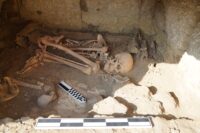 The Second Dynasty tomb is by far the oldest, but the mission also discovered numerous other rock-cut tombs from the Late Period (712–332 B.C.) and Ptolemaic era (304–30 B.C.), containing numerous artifacts including pottery, painted face masks, statuettes and amulets of deities like Isis, Harpocrates and Bes.
The Second Dynasty tomb is by far the oldest, but the mission also discovered numerous other rock-cut tombs from the Late Period (712–332 B.C.) and Ptolemaic era (304–30 B.C.), containing numerous artifacts including pottery, painted face masks, statuettes and amulets of deities like Isis, Harpocrates and Bes.